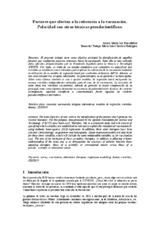Mostrar el registro sencillo del ítem
Factores que afectan a la reticencia a la vacunación. Polaridad con otras técnicas pseudocientíficas
| dc.contributor.author | Ríos Muñoz, María José | |
| dc.date.accessioned | 2022-01-24T12:49:37Z | |
| dc.date.available | 2022-01-24T12:49:37Z | |
| dc.date.issued | 2021 | |
| dc.identifier.issn | 2603-8099 | |
| dc.identifier.uri | http://hdl.handle.net/10396/22374 | |
| dc.description.abstract | El presente trabajo tiene como objetivo principal la identificación de aquellos factores que configuran posturas reticentes hacia la vacunación. Para ello se han utilizado datos oficiales proporcionados por la Fundación Española para la Ciencia y Tecnología (FECYT). Por tanto, se trata de un estudio estadístico que consistirá en especificar qué variables se establecen como relevantes para explicar la valoración de la vacunación mediante la utilización de un modelo de regresión lineal por cuadrados ordinarios (MCO). Además, se han seleccionado tres terapias adicionales: la quimioterapia, la acupuntura y la homeopatía. Sobre estas últimas también se van a ajustar modelos de regresión lineal incluyendo las mismas variables independientes utilizadas para el caso de la vacunación. La inclusión de estas otras tres variables secundarias, además de permitir la mejor comprensión de la principal, tiene como objetivo demostrar la existencia de polaridad entre técnicas de carácter contrapuesto: aquellas científicas o convencionales frente aquellas de carácter pseudocientífico o alternativo. | es_ES |
| dc.description.abstract | The main objective of this work is the identification of the factors which promote the vaccine hesitancy. For this purpose, data provided by the Spanish Foundation for Science and Technology (FECYT) have been used. Therefore, this is a statistical study that will consist of specifying which variables are established as relevant to explain the valuation of vaccination by using ordinary least-squares (OLS) regression. In addition, three other therapies have been selected: chemotherapy, acupuncture and homeopathy. Linear regression models will also be fit for these three variables, which will include the same independent variables as for vaccination case. The aim of the inclusion of these secondary therapies, in addition to allowing a better understanding of the main one, is to demonstrate the existence of polarity between these opposing therapies: those of a scientific or conventional nature versus those of a pseudo scientific or alternative nature. | es_ES |
| dc.format.mimetype | application/pdf | es_ES |
| dc.language.iso | spa | es_ES |
| dc.publisher | Universidad de Córdoba, Facultad de Derecho y CC. EE. y Empresariales | es_ES |
| dc.rights | https://creativecommons.org/licenses/by/3.0/ | es_ES |
| dc.source | RA&DEM 5, 53-81 (2021) | es_ES |
| dc.subject | Encuestas | es_ES |
| dc.subject | Vacunación | es_ES |
| dc.subject | Terapias alternativas | es_ES |
| dc.subject | Modelos de regresión | es_ES |
| dc.subject | Variables dummy | es_ES |
| dc.subject | STATA14 | es_ES |
| dc.subject | Surveys | es_ES |
| dc.subject | Vaccination | es_ES |
| dc.subject | Alternative therapies | es_ES |
| dc.subject | Regression modelling | es_ES |
| dc.subject | Dummy variable | es_ES |
| dc.title | Factores que afectan a la reticencia a la vacunación. Polaridad con otras técnicas pseudocientíficas | es_ES |
| dc.type | info:eu-repo/semantics/article | es_ES |
| dc.relation.publisherversion | https://www.uco.es/docencia_derecho/index.php/RAYDEM/index | es_ES |
| dc.rights.accessRights | info:eu-repo/semantics/openAccess | es_ES |

